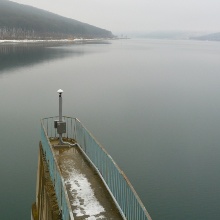The Workshop is co-funded by the German Research Foundation
(Deutsche Forschungsgemeinschaft – DFG)
General information:
Monitoring of structures and natural objects with regard to movements and deformations is one of the main tasks of engineering geodesy. Geometric changes of points can be detected with geodetic instruments, such as level instruments, total stations and GNSS receivers. Beside tachymeters, only GNSS receivers are able to measure the three-dimensional positions point-wise automatically and continuously. The geodetic GNSS receivers can achieve accuracies in the sub-cm range up to mm e.g. by using different time-based one-dimensional filter algorithms in monitoring systems. The use of small low-cost atomic oscillators with a stability of about 10-12 and higher in GNSS receivers and satellites opens new opportunities for monitoring of structures, natural objects and phenomena to control the measurements and increase their accuracy.
In recent years, new area-wise measuring methods such as stereoscopic image sequence analysis, terrestrial laser scanning and ground-based radar have been introduced for practical applications. Terrestrial laser scanner (TLS) is a new measurement instrument to acquire area- wise deformations with high-resolution. Laser scanning technology can be successfully used for geospatial monitoring of complicated industrial objects and structures (dams, bridges, tunnels and other complex engineering structures) providing accuracy about 1-10 mm. There are many different approaches for the derivation of deformations.
Punktbasierte Methoden erreichen eine hohe Informationsgenauigkeit für individuell beschriebene Punkte. Flächenbasierte Methoden liefern zwar die komplette Form eines Objekts mit einer hohen Auflösung, aber sehr oft mit einer reduzierten Genauigkeit. Die Genauigkeit und Zuverlässigkeit der flächenhaften Messmethoden sollte durch präzise punkthafte Messmethoden verbessert werden.
The point-based methods provide highly precise information for individually characterized points. The area-based methods provide the complete shape of the object in a high resolution and with an often reduced accuracy. The accuracy and reliability of the area wise measurement method should be improved through the precise point wise measurement method.
Area-wise monitoring can be carried out using stereoscopic images or image sequences, followed by photogrammetric processing involving image orientation and image matching, and resulting in a 3D point cloud similar to that of laser scanning. As a consequence, further processing of this point cloud to derive object movement etc. is very similar to that for laser scanning point clouds. Image acquisition can be done from static cameras with known (pre-calibrated) image orientation, or from moving platforms, e. g. unmanned aerial vehicles (UAV).
The potential of the integration of precise point-wise measurements and high resolution area-wise measurements to lead to a rigorous statistical deformation analysis scheme has not yet been systematically investigated, which constitutes a gap within the recent research in engineering geodesy. The information from point-wise measurements including the complete stochastic description in time and space shall be used to strengthen the information from the area-wise information especially with respect to the accuracy of modeling of surfaces and the reliability to detect edges and corners. This integration may be realized in geodetic adjustment or in Kalman filter approaches. The alternative is a Baysian estimation approach to combine the two data sources e.g. using the point-wise data as prior information for the estimation of the surfaces by the area-wise data. For example GNSS and TLS can be used to improve functional safety of high liability hydro technical constructions and dams at hydroelectric power stations and, consequently, the safety of the population in the surrounding areas. The integration of point-wise measurements with physical models of structures by means of FEM in case of a static and dynamic behavior of structures leads to the topic of “Structural Health Monitoring”. In that integration case the point-wise geodetic geodetic displacements and the nodal point displacements can be leaded together by the FEM shape functions, and “unhealthy” physical structures, can be identified by adequate parametrizations or –parameter-changes in the characteristic FEM matrices (stiffness-, damping- and mass-matrix).
The round-table discussion will be devoted to leading research in the field of integration of point- and area-wise deformation analysis, and defining and developing future research targets.
Key issues are as follows:
Objects under observation: Industrial and civilian, public utilities (hydro technical constructions, atomic and thermal power plants), mining plants, minery, shafts, tunnels, linear structures (highways, roads, pipelines, power transmission lines), landslides, glaciers, etc.
Methods of observations and measurements: Leveling, line-and-angle, laser scanning, Earth remote sensing, aerospace surveys (aerial and GPS surveys), radar. and georadar surveys, mine surveying, gravity surveys, interference control techniques, GNSS and MEMS technologies
Monitoring data processing and interpretation: Software tools for geodata analysis, processing, interpretation and visualization, algorithmization and estimation concepts of geodetic observations and mathematical methods of analysis, integrated and system analysis related monitoring approaches, structural health-monitoring processing and interpretation, cloud computing technologies.
Contact:

Volker Schwieger
Prof. Dr.-Ing. habil. Dr. h.c.Director of the Institute



